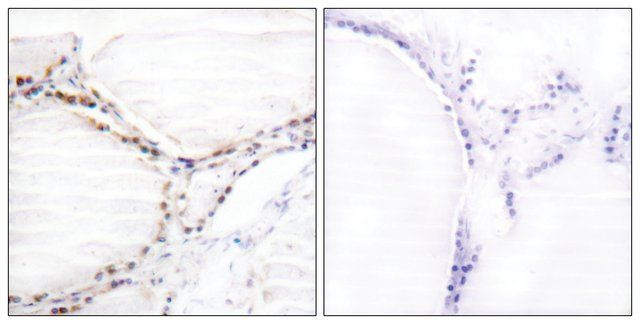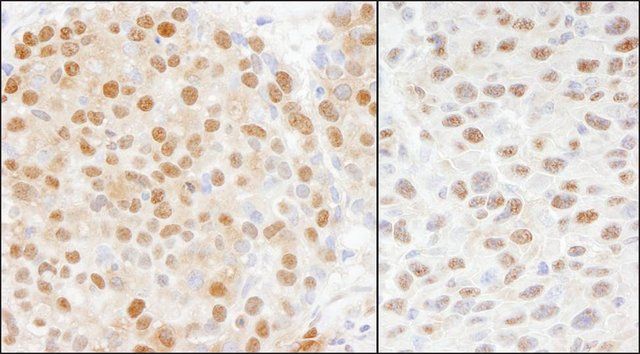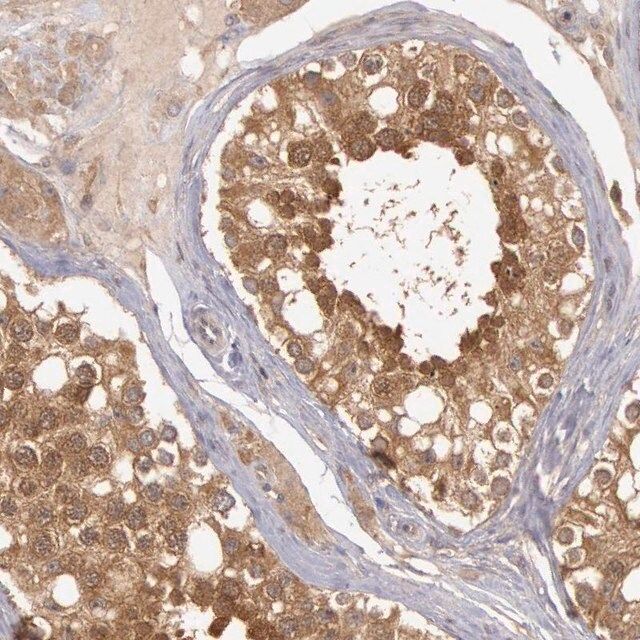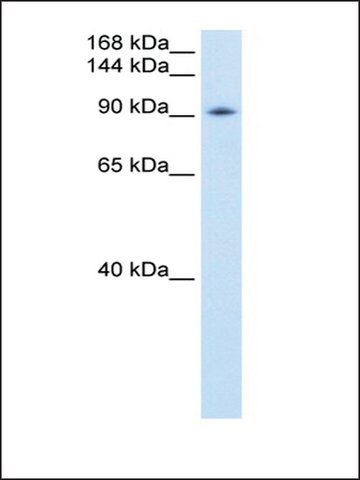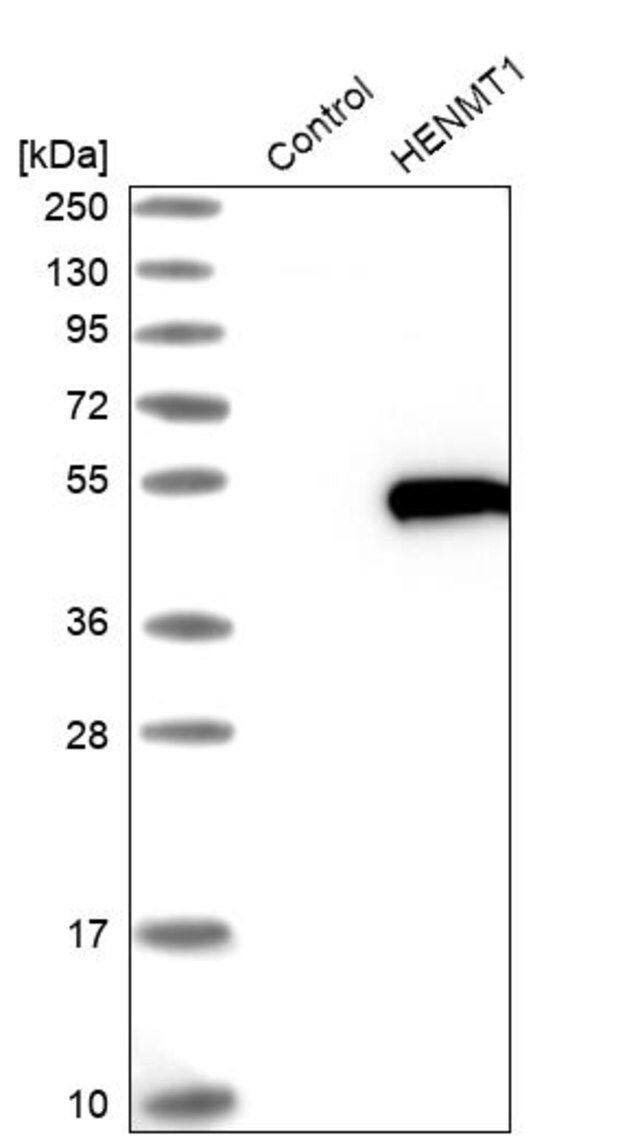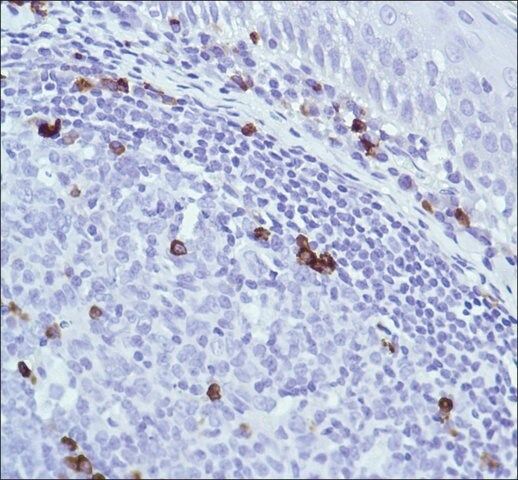产品说明
一般描述
DNA helicase MCM9 (EC 3.6.4.12; UniProt Q9NXL9; also known as hMCM9, Mini-chromosome maintenance deficient domain-containing protein 1) is encoded by the MCM9 (also known as C6orf61, MCMDC1, ODG4) gene (Gene ID 254394) in human. Mammalian minichromosome maintenance (MCM) protein homologues MCM8 and MCM9 play important roles in DNA replication elongation and prereplication complex (pre-RC) formation. MCM9 is found physically interacted with MCM8 and the interaction is essential for MCM9 cellular stability. MCM8-MCM9 complex is required for homologous recombination- (HR-) mediated repair of double-strand breaks (DSBs). In addition, the ATPase motifs of MCM8 and MCM9 (a.a. 523-530) are needed for MRN (MRE11-RAD50-NBS1) complex recruitment to DSBs sites. Cancer cells with MCM9 homozygous deletion display enhanced reduction in cell survival following exposure to interstrand-crosslinking (ICL) agents, such as cisplatin, due to impaired HR efficiency.
特异性
This rabbit polyclonal antiserum detected DNA damage-induced MCM9 nuclear foci formation in U2OS and wild-type, but not Mcm9-null MEFs (Park, J., et al. (2013). Mol. Cell. Biol. 33(8):1632-1644). The C-terminal end epitope region is present in all four human MCM9 spliced isoforms and the first two mouse MCM9 isoforms reported by UniProt (Q9NXL9 and Q2KHI9).
免疫原
Recombinant human MCM9 C-terminal fragment.
Epitope: C-terminus
应用
Chromatin Immunoprecipitation (ChIP) Analysis: A representative lot detected a time-dependent MCM9 recruitment to the integrated I-scel cleavage site in a RAD51-independent manner in HeLa DR13-9 cells following I-scel transfection (Park, J., et al. (2013). Mol. Cell. Biol. 33(8):1632-1644).
Chromatin Immunoprecipitation (ChIP) Analysis: A representative lot detected a time-dependent MCM9 recruitment to the intrastrand cross-link (ICL) site of the pICL plasmid in xenopus egg extract followng induction of replication-dependent repair (Park, J., et al. (2013). Mol. Cell. Biol. 33(8):1632-1644).
Immunocytochemistry Analysis: A representative lot detected DNA damage-induced MCM9 nuclear foci formation co-colocalized with RPA immunoreactivity by fluorescent immunocytochemistry staining of 0.5% Triton X-100-permeabilized, 4% paraformaldehyde-fixed human U2OS and mouse embryonic fibroblasts (MEFs) following cisplatin treatment. No target staining was seen in Mcm9-null MEFs (Park, J., et al. (2013). Mol. Cell. Biol. 33(8):1632-1644).
Immunoprecipitation Analysis: A representative lot co-immunoprecipiated MRN (MRE11-RAD50-NBS1) complex with MCM9 from U2OS and HEK293T cells (Lee, K.Y., et al. (2015). Nat. Commun. 6:7744).
Immunoprecipitation Analysis: A representative lot co-immunoprecipiated MCM8 and RAD51 with MCM9 from U2OS and HEK293T nuclear extracts. The antiserum also immunodepleted MCM9 in xenopus egg extract (Park, J., et al. (2013). Mol. Cell. Biol. 33(8):1632-1644).
Western Blotting Analysis: A representative lot detected MCM9 downreguation in prostate cancer cells and NCI-H1299, but not NCI-H2291, non-small cell lung cancer (NSCLC) cells fig1, 2, S1 (Lee, K.Y., et al. (2015). Nat. Commun. 6:7744).
Western Blotting Analysis: Representative lots detected MCM9 in U2OS cells. Transfecting cells with shRNA targeting either MCM8 or MCM9 downregulated cellular MCM9 level (Lee, K.Y., et al. (2015). Nat. Commun. 6:7744; Park, J., et al. (2013). Mol. Cell. Biol. 33(8):1632-1644).
Research Category
Epigenetics & Nuclear Function
Anti-MCM9, Cat. No. ABE2603, is a highly specific rabbit polyclonal antibody that targets DNA helicase MCM9 and has been tested in Chromatin Immunoprecipitation (ChIP), Immunocytochemistry, Immunoprecipitation, and Western Blotting.
质量
Evaluated by Western Blotting in HEK293 cell lysate.
Western Blotting Analysis: A 1:500 dilution of this polyclonal antiserum detected MCM9 in 10 µg of HEK293 cell lysate.
目标描述
~130 kDa observed. 127.3/72.74/43.98/84.44 kDa (human isoform 1/2/3/4), 125.8/142.4 kDa (mouse isoform 1/2), 126.6 kDa (xenopus) calculated. Uncharacterized band(s) may appear in some lysates.
外形
Unpurified
Rabbit polyclonal antibody serum with 0.05% sodium azide.
储存及稳定性
Stable for 1 year at -20°C from date of receipt.
Handling Recommendations: Upon receipt and prior to removing the cap, centrifuge the vial and gently mix the solution. Aliquot into microcentrifuge tubes and store at -20°C. Avoid repeated freeze/thaw cycles, which may damage IgG and affect product performance.
其他说明
Concentration: Please refer to lot specific datasheet.
免责声明
Unless otherwise stated in our catalog or other company documentation accompanying the product(s), our products are intended for research use only and are not to be used for any other purpose, which includes but is not limited to, unauthorized commercial uses, in vitro diagnostic uses, ex vivo or in vivo therapeutic uses or any type of consumption or application to humans or animals.
基本信息
| eCl@ss | 32160702 |
产品性质
| 生物来源 | rabbit |
| 质量水平 | 100 |
| 抗体形式 | serum |
| antibody product type | primary antibodies |
| 克隆 | polyclonal |
| species reactivity | mouse, human, Xenopus |
| technique(s) | ChIP: suitable immunocytochemistry: suitable immunoprecipitation (IP): suitable western blot: suitable |
| NCBI登记号 | NP_060166 |
| UniProt登记号 | Q9NXL9 |
| 运输 | ambient |
安全信息
| 储存分类代码 | 12 - Non Combustible Liquids |
| WGK | WGK 1 |
| 闪点(F) | Not applicable |
| 闪点(C) | Not applicable |




